What Is The Main Difference Between Thai Curry And Indian Curry?
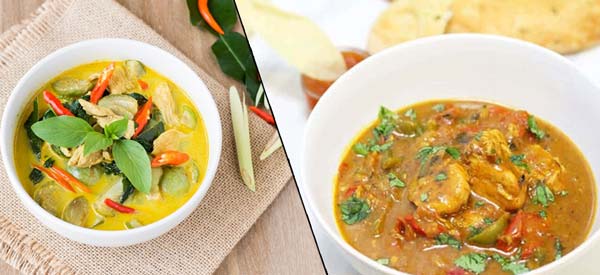
Food is unquestionably one of life’s most fundamental necessities, but it is far from the only one. Many people enjoy food, and in keeping with this desire, this article will undoubtedly inform you about some intriguing facts regarding Thai and Indian curries.
I’m a gourmet through and through. I enjoy eating; thus, I enjoy trying new foods and experimenting with different flavors. The notion that what emerged as the distinctions between the Indian and Thai curry hit me recently, and so here I am with this essay sharing with you all my conclusions gained from examining the two cuisines.
My findings in the culinary industry led me to the conclusion that Indian curries generally comprises turmeric, cumin, and coriander. It’s also good with curry leaves cooked in it. Indian curry sauces are often lighter than Thai curry sauces. On the other hand, Thai curry employs a thick sauce made of various curry pastes blended with coconut milk and cooked meat and vegetables.
But that’s not all. There’s a lot more to it than the simple changes I mentioned earlier. Both of the cuisines in question are incredible, and it’s essential to understand the variations between the curry in each of them.
This essay will delve further into the facts to determine the Top Differences Between Indian and Thai Curry.
But, before we go into the specifics of how the curry in two distinct cuisines differs, let’s first address the most fundamental issue about the topic:
What exactly is curry?

The name ‘Curry’ originated from the Tamil people of India and Sri Lanka. This word was first used to describe a range of meat and vegetable meals prepared without sauce and cooked with a spice rub combination.
So, to continue the conversation,
The usage of the curry plant for producing the spice rub is one of the pillars that can be seen in Indian Curry. Ironically, the curry plant leaves are absent from most spice mixes labeled curry powder.
Another amusing reality is that most of our perceptions of Indian cuisine are strongly influenced by British culture. Without a doubt, England formerly occupied India, and many individuals of Indian heritage have resided in the United Kingdom. Curry powder and even Chicken Tikka Masala are, therefore, British innovations.
The name ‘curry’ has expanded widely across Asia over time, with several Asian nations, including Thailand, adopting it. Curry paste, which can be red, yellow, or green, is commonly used in Thai cuisine. However, there are a variety of additional options. To make a sauce, combine the paste with coconut milk.
So, that is how the name ‘curry’ came to be, and the context in which it is used today is as indicated above. After reading this, we can now turn our attention to the subject at hand: Is there a difference between Thai and Indian curry?
So keep an eye out!
We’re getting to the end of the article’s central section, which we’ll go over in detail.
Is there a distinction to be made between Thai and Indian curry?

In a nutshell, the answer to this question is a resounding YES!
Indian Curry, which is the earliest, employs a mixture of Indian spices as a rub over meat and vegetables. While the meat and vegetables are cooked with tomatoes, they are not too sauced.
On the other hand, Thai curry is prepared with a variety of curry pastes that, unlike spice blends, are produced from fresh ingredients and have a thick, wet consistency. After that, the curry paste is blended with coconut milk to make a thick sauce.
The spiciness of the curry is determined by the amount of curry paste used. However, for a big pot of curry, a few teaspoons are generally plenty.
The similarities between the two may be seen in the flavor, which is something that everyone who enjoys food strives for in a meal. Both the Indian and Thai curries have a depth of taste and intriguing spices in common.
The use of turmeric for color and fresh cilantro leaves as a topping might improve these two meals even further. It would produce an Indian curry and a Thai curry with a twist that everyone would like.
Let’s take a closer look at both Indian and Thai curry.
What is Thai Curry exactly?

Thai curry is typically divided into the following categories:
- A shade of green (the hottest)
- The color yellow (the mildest)
- The color red (in the middle)
- Panang (similar to red but with a bit of tang from shrimp paste)
- Massaman (milder and sweeter, often containing peanuts)
The foundation components in all of the Thai curries mentioned above are ginger, garlic, lemongrass, Galangal (Thai ginger), and chili peppers. However, the method in which the chiles are utilized is one of the key ways in which one type of Thai Curry differs from another.
Green chiles are used extensively in preparing the Green Curry, which is historically regarded as the hottest of all the curries. Red curry is made using red chilies, which give it a gentler flavor and a characteristic red hue. Yellow Thai Curry has much turmeric, which gives it its unique hue. It has the fewest chili peppers of all Thai curries, making it the mildest of all Thai curries.
What exactly are Indian curries?
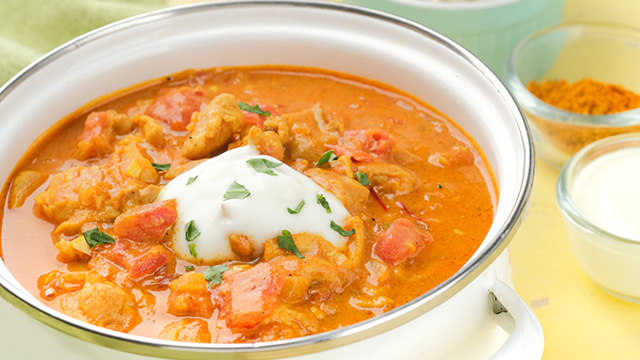
Curry powder in a jar is a British innovation that dates back to the occupation of India by the British.
Curry refers to a spice mix in India; however, this does not imply that the same combination of spices is used in every meal. Instead, different mixes of spices are employed to prepare various sorts of foods. These combinations vary depending on the preferences of individuals in various parts of the country.
However, with that in mind, the following are some of the most frequent spices that are commonly used in the preparation of the dish:
- Coriander is a kind of coriander that is (the powder made from dried cilantro seeds)
- Cumin
- Turmeric
- Chili powder with cayenne
Other Indian spices are included in this list as well. Cinnamon and ginger powder are not historically used in the curry to clear up a widespread misunderstanding. Ginger is a primary ingredient in Indian food, but it is almost always done with fresh ginger, not powdered ginger. Cinnamon is a significant ingredient in garam masala powder, which is often added at the end of the cooking process.
Let’s continue with the topic by answering the hilarious question we faced previously, which is,
Why aren’t the curry plant leaves included in most curry powders?
To answer this issue quickly and succinctly, as the curry plant’s leaves dry, they lose their exquisite and unique flavor.
Curry leaves are a staple in Indian cuisine, particularly in South India. However, as previously indicated, dried leaves tend to lose their flavor. This is why, to give the meals a particular flavor, only fresh curry leaves are utilized.
Is Thai Curry similar to Indian Curry?
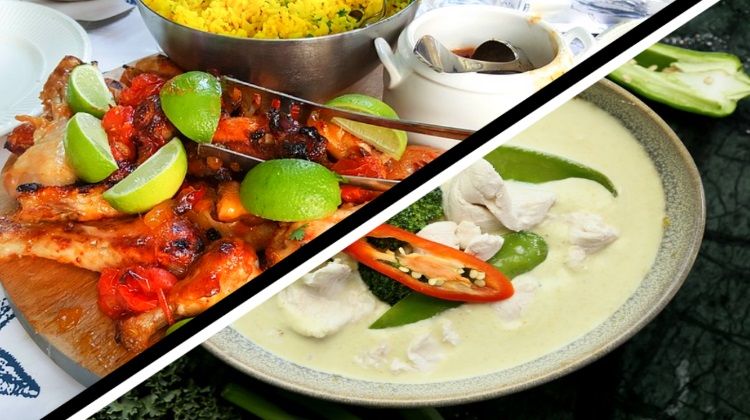
The quick answer is no, and that’s what piqued my interest in trying to find out the distinctions between the two.
While some components, including ginger, garlic, turmeric, chili peppers, and cilantro, are similar, their flavors vary across the two cuisines.
Depending on personal choice, both Indian and Thai curry can be made hotter or milder. However, I have always found Thai curry to be a little hotter. Thai curry likewise uses a lot of coconut milk, but Indian curry is more spice-driven and less sloppy.
Another distinction is that when Indian food gets saucy, it tends to rely significantly on ghee (clarified butter) and cream in many dishes, but Thai food does not. Dried cilantro leaves are also used in Indian cuisine, although fresh cilantro leaves are generally used in Thai cuisine.
As a result, they have nothing in common in terms of taste.
Which Thai Curry Is the Best?
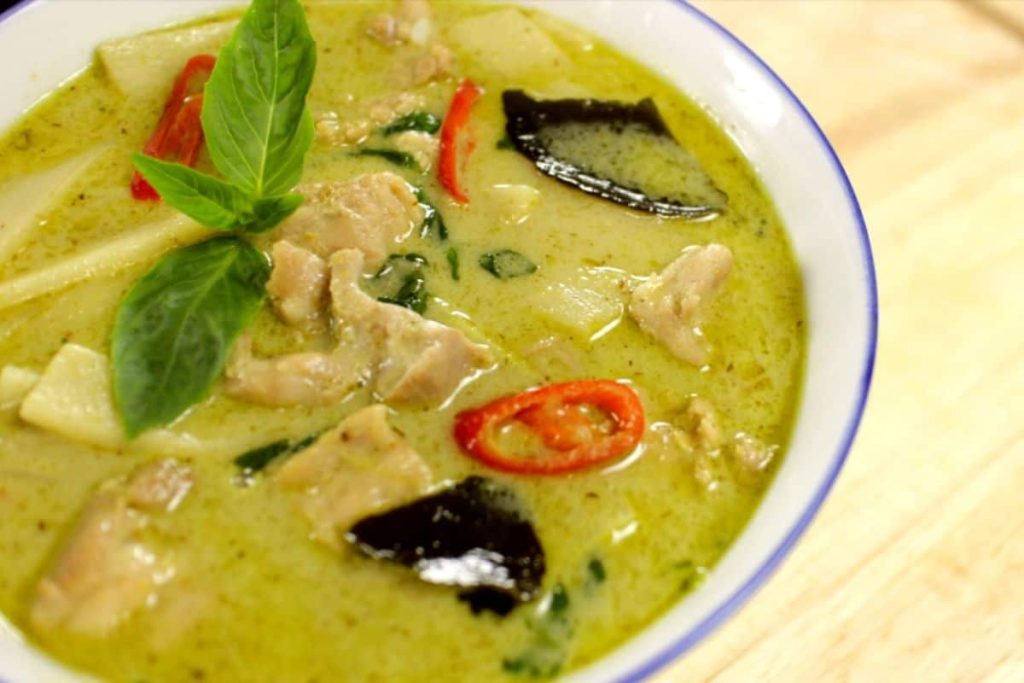
Best is a very subjective adjective that is based on personal tastes. What is best for me may not be the best for you.
However, based on my observations, green curry appears to be the most popular of the three. Yellow, Panang, and massaman curry are the least popular of all kinds of curry.
On the other hand, Panang is my favorite since it has a lovely tang from the shrimp paste. Although it is hot, the heat does not overshadow the flavor, as is sometimes the case with green curry. However, I enjoy practically all curries. There isn’t a single one that I don’t like. So, my advice is to test them all and select the best one for you.
Which of the Thai curries is the mildest?
To keep in mind, Thai curries begin with curry paste, so you can adjust the heat level by adding more or less of it. Coconut milk is added after the original paste is sautéed in some oil with chopped onion and garlic.
Green curry and red curry, on the other hand, receive their various hues from chili peppers, which is relevant to the subject at hand. Because turmeric gives yellow curry its color, it is frequently the mildest.
Which Thai curry has the most heat?
I believe Green Curry would be a strong contender for this title since fresh green chilies give green curry its characteristic color and intensity.
Green chilies are picked off the vine when they are at their hottest, making them less expensive than red chilies, which are permitted to linger on the vine for extended periods, reducing the farmer’s yield. The truth is that the longer it sits on the vine, the softer it becomes.
What are the most common spices used in Indian cuisine?
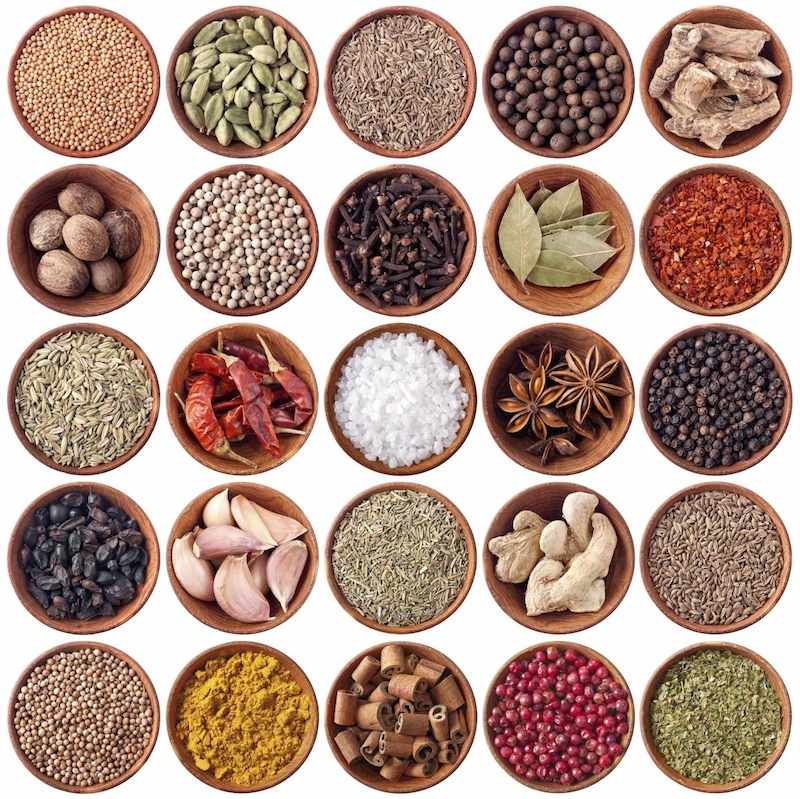
The beauty of Indian cuisine is that each dish has its distinct combination of spices to achieve the optimum flavor. Each meal has its unique spice combination, making each dish stand out from the others.
As a result, not all of the spices are utilized in each meal. However, the following are some of the most often used Indian spices:
- Turmeric
- Coriander
- Cumin
- Fenugreek
- Asafoetida is a plant that contains asafoetida (hing)
- Cardamom
- Mustard grain
- Saffron
- Masala garam (itself a mixture of cinnamon, clove, coriander, cardamom & cumin)
What’s the difference between Garam Masala and Madras Curry?
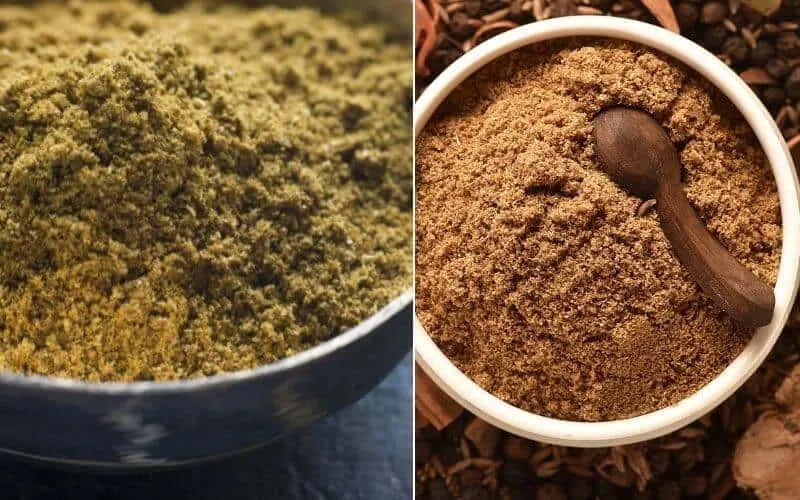
Garam masala is a spice combination made up of cinnamon, clove, coriander, cardamom, and cumin that is widely used in India. It’s frequently added to foods after they’ve been cooked. As a result, it functions as a garnish that is sprinkled on top.
On the other hand, Madras curry is a British innovation based on Indian cuisine during the British colonialism of India. It can refer to a curry powder or a curry sauce. Chili powder is used liberally, and the meal is typically mellowed (a bit) with the addition of yogurt.
It also contains tamarind, which has a raisin-like sweetness, giving it a sweet and sour flavor.
As a result, there is a significant difference between Garam Masala and Madras Curry.
How can you tell the difference between Indian and Jamaican curry?
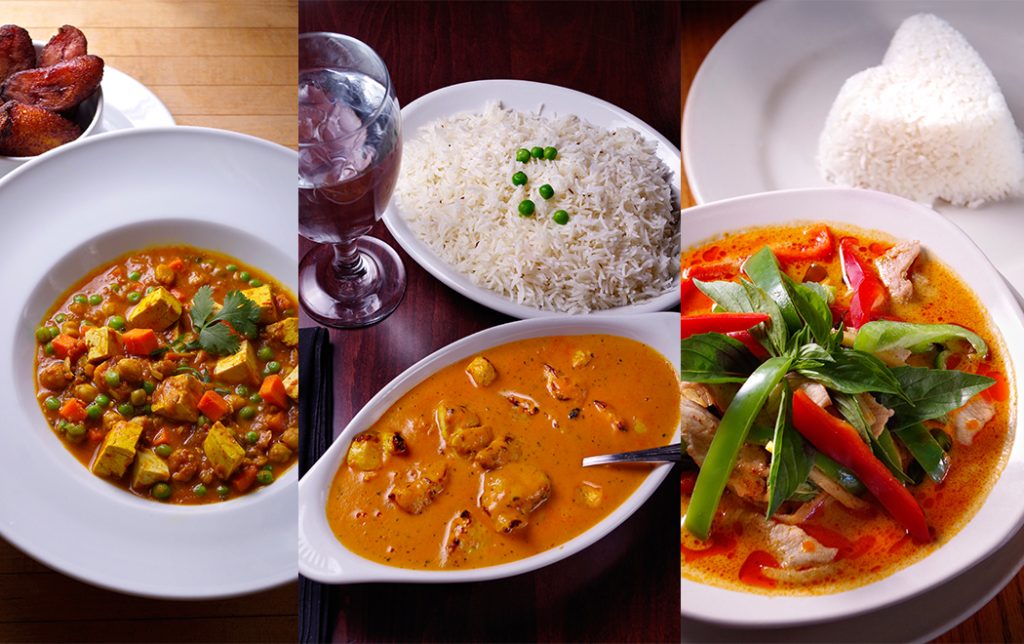
Unlike Indian curry powder, which is a British innovation that is rarely seen in India, Jamaican curry is a popular dish throughout the Caribbean.
Allspice, which has a licorice-like taste, and thyme are the main ingredients in Jamaican curry. Allspice and, mainly, thyme, on the other hand, are rarely, if ever, used in Indian cooking.
Because Jamaican curry uses fresh chili peppers instead of chili powder, Jamaican curry powder isn’t particularly hot. However, turmeric powder, coriander, cumin, and fenugreek are used extensively in both cuisines.
Okay,
So, now that you’ve learned a lot about Indian and Thai curry, let’s look at the nine distinctions between the two.
Indian and Thai Curry Have 9 Surprising Differences
Both of these cuisines have a strong affinity for garlic, onion, cumin, and fresh cilantro leaves. Apart from that, the two are entirely different, as the following pointers will demonstrate:
No.1 The basis of Thai curry is coconut milk, although coconut milk is nearly never used in Indian curry.
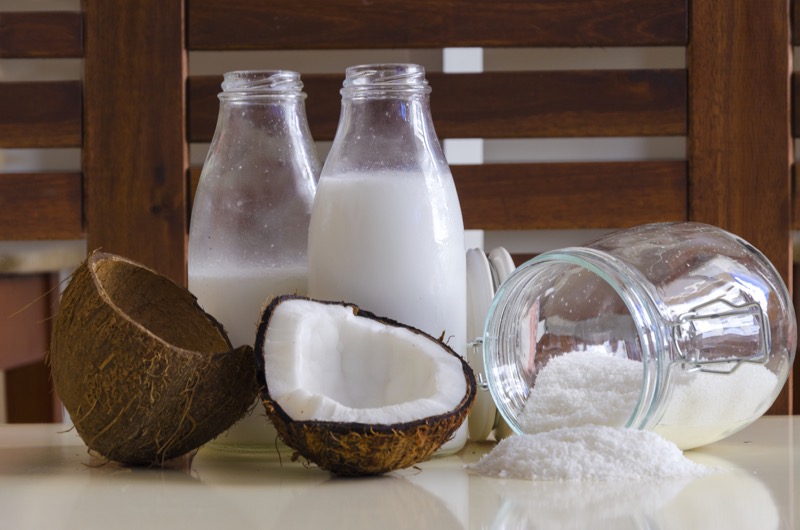
The fact that Coconut Milk is a significant component in Thai Curry is the first distinction to make between the two. When creating Thai Curry, a lack of coconut milk is not an acceptable compromise.
Indian curry, on the other hand, is a spice combination. Though coconut oil, yogurt, milk, and other similar ingredients may be required in some sauces, they are not required. Tomato sauces, on the other hand, are famous in India.
No.2 Jarred curry powder is a British invention that is not used in Thai cooking.
Since the British occupation of India from 1858 to shortly after World War II and the fact that a large number of Indian families have immigrated to the UK over the decades, the UK is well versed in Indian cuisine.
Thus, curry powder, which can be found on the shelves of any grocery shop in the United States and the United Kingdom, is a British creation and is not used in Thai curry.
No.3 Thai curries begin with curry paste, which is made from fresh rather than dried ingredients.
Although curry powder mixes may be found in India, they originated in the United Kingdom. On the other hand, Thai curries usually begin with curry paste, which is a mashed mixture of fresh vegetables and herbs such as garlic, onion, lemongrass, Galangal, and chile peppers that do not include any dried herbs or spices other than salt and pepper.
No.4 Fresh cilantro leaves are frequently used as a garnish in Thai cuisine; however, the cilantro plant’s dried seeds are never utilized (coriander)
Coriander Powder is a unique ingredient used in Indian cuisine. It is just the fresh leaves of the cilantro plant that are frequently used as a garnish in both cuisines. It is never used in Thai cooking.
No.5 The use of dairy products in Indian cuisine sets it apart from Thai cuisine.
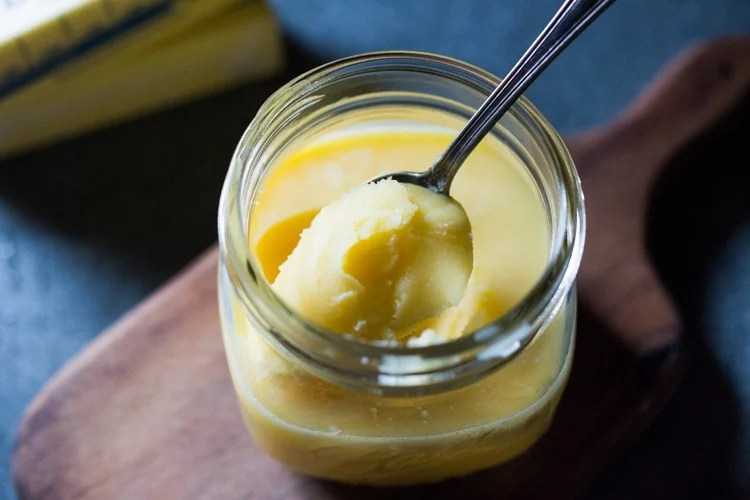
Almost every Indian cuisine begins with ghee (clarified butter) and may include heavy cream or yogurt-based sauces. Ghee is an Indian innovation that is used to saute virtually everything in Indian cuisine. Cream and yogurt are frequently used to make rich sauces in Indian cuisine.
On the other hand, Thai food is often prepared using coconut oil, palm oil, peanut oil, or soy oil rather than butter or ghee. In reality, dairy products are rarely used in Thai cooking.
No.6 In contrast to Thai food, which is served with Jasmine rice, Indian food is typically served with Basmati rice.
Although both Indian and Thai cuisines like offering rice to complement their meals, the preferred kind differs. Indians enjoy Basmati Rice, a bowl of fragrant, long-grain rice with a mild popcorn fragrance when cooked.
On the other hand, Thai cuisine favours Jasmine Rice, which is a long-grain rice with a flowery flavor. It also loses flavor more quickly, so look for vacuum-sealed jasmine rice.
No.7 The curry plant’s leaves are commonly boiled in traditional Indian curries; however, they are not utilised in Thai cuisine.
Curry leaves are rarely used in canned curry powders since they don’t taste much when dried. As a result, they’re commonly cooked in Indian dishes before being tossed out like a bay leaf. On the other hand, Thai cuisine does not utilize curry leaves at all.
No.8 While ginger is used in Thai and Indian cuisines, Thai ginger, also known as Galangal, has a distinct flavor.
Under the rhizomes family of root vegetables, Galangal and ginger are related. As a result, regular ginger cannot be used in place of Galangal, which distinguishes the two. On the other hand, Galangal has a rootsy and lemony flavor. It is significantly more robust in flavor, despite its similar appearance.
No.9 Rice can be used to replace rice noodles in Thai cuisine, although no noodle is used in Indian cuisine.
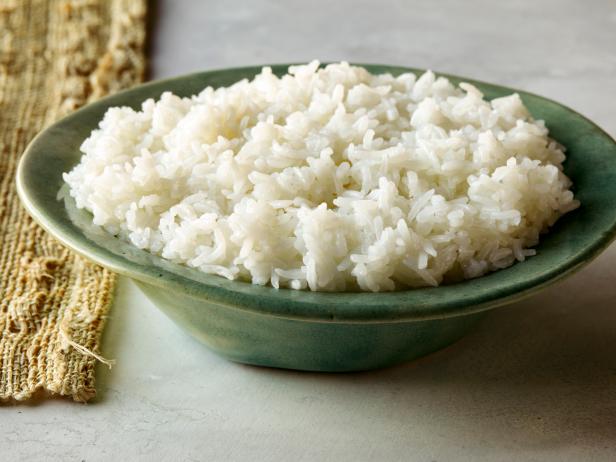
Rice noodles, whether thin and delicate like angel hair or larger and flatter like fettuccine, are classics in Thai cuisine, though they also like jasmine rice.
On the other hand, India does not utilise any pasta. It relies only on rice as a starchy side dish, whether simple steamed basmati rice, pulao, or biryani, which are more like rice pilaf or a bowl of stir-fried rice.
So, those are the primary distinctions between Indian and Thai curry that I can think of. On the other hand, both cuisines are excellent and have distinct tastes.
As a result, the article’s goal has been achieved, and we may now go on to the next section.
Conclusion
After reading this essay and considering the reasons, we can conclude that Thai and Indian curry are vastly different and taste nothing alike. On the other hand, both have distinct characteristics and flavors that make them taste fantastic. It’s now up to you to discover your personal preferences and determine which one you prefer.
With that, I wish you a pleasant dining experience!











